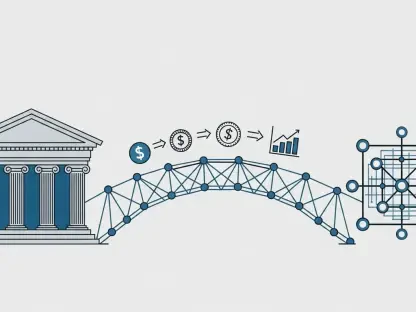In a significant shift signaling the fusion of traditional finance with digital innovation, Goldman Sachs and Bank of New York Mellon have initiated the tokenization of money market funds through blockchain. This advancement signifies a broader interest in integrating crypto infrastructure into conventional financial frameworks. By moving toward tokenization, investors can now hold digital tokens representing shares in funds managed by influential entities such as BlackRock and Fidelity. This is part of a growing trend where financial institutions are increasingly exploring the creation of digital representations of tangible assets on distributed ledgers. Utilizing these tokenized funds aims to enhance collateral efficiency and enable swifter transactions, reflecting an evolving landscape in finance where traditional mechanisms are being challenged by new technologies.
The Mechanics Behind Tokenization
Goldman Sachs plans to employ its proprietary GS DAP blockchain to meticulously track token ownership, offering a digital ledger system that facilitates accurate and transparent transactions. Simultaneously, Bank of New York Mellon will handle the official books and settlements through its LiquidityDirect cash-management platform. This collaboration exemplifies how established financial entities are leveraging blockchain technology to introduce innovative solutions in asset management. This initiative aligns with recent U.S. regulations, particularly under the Genius Act, which encourages the adoption and growth of tokenized assets. Through these regulatory frameworks, financial institutions are finding pathways to legally and efficiently implement digital solutions in traditional finance, highlighting a pragmatic shift in regulatory attitudes toward financial technology.
Proponents argue that the use of tokenization can significantly streamline financial transactions, potentially lowering operating costs due to reduced reliance on intermediaries. Tokenization also facilitates instant settlements and the fractionalization of asset ownership, making it easier for investors to diversify their portfolios without the traditional constraints of asset classes. However, concerns remain about market volatility and cybersecurity threats, which are intrinsic risks associated with newly digitized processes. While the integration of blockchain in asset management heralds potential cost and time efficiencies, financial institutions must navigate these technological challenges carefully. The balance between innovation and risk mitigation remains critical as traditional finance continues its digital metamorphosis.
Potential Impact and Future Trends
With U.S. money market funds estimated at $7.1 trillion, the potential growth for tokenized assets within this sector is enormous. The move toward blockchain applications in finance underscores the industry’s keen interest in enhancing operational productivity through innovative technologies. By integrating blockchain, institutions aim to remove inefficiencies that have long plagued traditional financial systems, offering a potential paradigm shift that can redefine how transactions are executed. The tokenization of existing financial products not only opens new avenues for asset liquidity but also democratizes investment opportunities, giving wider access to various asset classes previously limited to certain demographics.
Yet, the shift toward tokenization is not without its challenges. Market participants must address the volatility and security of digital assets, safeguarding against breaches and regulatory missteps. While the benefits of increased transparency and reduced transaction times are clear, the path to widespread adoption involves navigating complex regulatory environments and public skepticism. As companies continue to adopt blockchain infrastructure, there will be an inevitable push for stronger regulatory oversight to ensure market stability and consumer protection. Ultimately, the success of tokenization in finance will depend on balancing innovation with a robust framework to foster trust and widespread acceptance.
Conclusion: The Road Ahead
Goldman Sachs is set to employ its proprietary GS DAP blockchain to thoroughly monitor token ownership, establishing a digital ledger for clear and precise transactions. Concurrently, Bank of New York Mellon will manage official records and settlements using its LiquidityDirect cash-management platform. This collaboration illustrates how established financial institutions are using blockchain to introduce cutting-edge solutions in asset management. This move aligns with recent U.S. regulations, particularly the Genius Act, which promotes the growth and adoption of tokenized assets. These regulatory frameworks enable financial institutions to legally and efficiently integrate digital solutions into traditional finance, marking a pragmatic shift in regulatory approaches to financial technology.
Supporters believe that tokenization can greatly enhance financial dealings, potentially reducing operating costs by decreasing dependency on middlemen. Tokenization also enables instant settlements and allows for fractional asset ownership, easing investor diversification. Despite these benefits, concerns about market volatility and cybersecurity threats persist, as they are inherent risks in digital processes. As asset management embraces blockchain, institutions must cautiously balance innovation and risk, highlighting a careful evolution in traditional finance.









